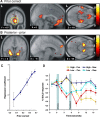The role of the ventromedial prefrontal cortex in abstract state-based inference during decision making in humans
- PMID: 16899731
- PMCID: PMC6673813
- DOI: 10.1523/JNEUROSCI.1010-06.2006
The role of the ventromedial prefrontal cortex in abstract state-based inference during decision making in humans
Abstract
Many real-life decision-making problems incorporate higher-order structure, involving interdependencies between different stimuli, actions, and subsequent rewards. It is not known whether brain regions implicated in decision making, such as the ventromedial prefrontal cortex (vmPFC), use a stored model of the task structure to guide choice (model-based decision making) or merely learn action or state values without assuming higher-order structure as in standard reinforcement learning. To discriminate between these possibilities, we scanned human subjects with functional magnetic resonance imaging while they performed a simple decision-making task with higher-order structure, probabilistic reversal learning. We found that neural activity in a key decision-making region, the vmPFC, was more consistent with a computational model that exploits higher-order structure than with simple reinforcement learning. These results suggest that brain regions, such as the vmPFC, use an abstract model of task structure to guide behavioral choice, computations that may underlie the human capacity for complex social interactions and abstract strategizing.
Figures




Comment in
-
Simple reinforcement learning models are not always appropriate.J Neurosci. 2006 Nov 8;26(45):11511-2. doi: 10.1523/jneurosci.3973-06.2006. J Neurosci. 2006. PMID: 17106946 Free PMC article. Review. No abstract available.
Similar articles
-
Reward-related reversal learning after surgical excisions in orbito-frontal or dorsolateral prefrontal cortex in humans.J Cogn Neurosci. 2004 Apr;16(3):463-78. doi: 10.1162/089892904322926791. J Cogn Neurosci. 2004. PMID: 15072681
-
Modulation of value-based decision making behavior by subregions of the rat prefrontal cortex.Psychopharmacology (Berl). 2020 May;237(5):1267-1280. doi: 10.1007/s00213-020-05454-7. Epub 2020 Feb 6. Psychopharmacology (Berl). 2020. PMID: 32025777 Free PMC article.
-
The neuropsychology of ventral prefrontal cortex: decision-making and reversal learning.Brain Cogn. 2004 Jun;55(1):41-53. doi: 10.1016/S0278-2626(03)00284-7. Brain Cogn. 2004. PMID: 15134842 Review.
-
Dissociating Value Representation and Inhibition of Inappropriate Affective Response during Reversal Learning in the Ventromedial Prefrontal Cortex.eNeuro. 2016 Jan 4;2(6):ENEURO.0072-15.2015. doi: 10.1523/ENEURO.0072-15.2015. eCollection 2015 Nov-Dec. eNeuro. 2016. PMID: 26730406 Free PMC article.
-
Sex differences in early childhood, adolescence, and adulthood on cognitive tasks that rely on orbital prefrontal cortex.Brain Cogn. 2004 Jun;55(1):134-47. doi: 10.1016/S0278-2626(03)00279-3. Brain Cogn. 2004. PMID: 15134848 Review.
Cited by
-
Brain tissue- and cell type-specific eQTL Mendelian randomization reveals efficacy of FADS1 and FADS2 on cognitive function.Transl Psychiatry. 2024 Feb 5;14(1):77. doi: 10.1038/s41398-024-02784-4. Transl Psychiatry. 2024. PMID: 38316767 Free PMC article.
-
Functional correlates of likelihood and prior representations in a virtual distance task.Hum Brain Mapp. 2016 Sep;37(9):3172-87. doi: 10.1002/hbm.23232. Epub 2016 May 11. Hum Brain Mapp. 2016. PMID: 27167875 Free PMC article.
-
Creating the brain and interacting with the brain: an integrated approach to understanding the brain.J R Soc Interface. 2015 Mar 6;12(104):20141250. doi: 10.1098/rsif.2014.1250. J R Soc Interface. 2015. PMID: 25589568 Free PMC article. Review.
-
Genetic variation in dopaminergic neuromodulation influences the ability to rapidly and flexibly adapt decisions.Proc Natl Acad Sci U S A. 2009 Oct 20;106(42):17951-6. doi: 10.1073/pnas.0905191106. Epub 2009 Oct 12. Proc Natl Acad Sci U S A. 2009. PMID: 19822738 Free PMC article.
-
Serotonin affects association of aversive outcomes to past actions.J Neurosci. 2009 Dec 16;29(50):15669-74. doi: 10.1523/JNEUROSCI.2799-09.2009. J Neurosci. 2009. PMID: 20016081 Free PMC article.
References
-
- Bechara A, Tranel D, Damasio H (2000). Characterization of the decision-making deficit of patients with ventromedial prefrontal cortex lesions. Brain 123:2189–2202. - PubMed
-
- Camerer CF (2003). Strategizing in the brain. Science 300:1673–1675. - PubMed
-
- Daw ND, Niv Y, Dayan P (2005). Uncertainty-based competition between prefrontal and dorsolateral striatal systems for behavioral control. Nat Neurosci 8:1704–1711. - PubMed
Publication types
MeSH terms
LinkOut - more resources
Full Text Sources
